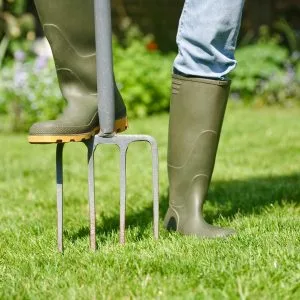Throughout the year, grass in your yard takes a beating. People, pets, and even equipment like lawn mowers trample all over it. Snow and rain beat down. Dead grass and debris pile up creating a thick layer of thatch. This all contributes to soil compaction. When soil is compacted or the layer of thatch is too thick, food, air, and water can’t get through to the grass and plant root systems to help in the growth process. What can you do? Here’s how to help with some do-it-yourself lawn aeration tips.
What Is Lawn Aeration?
Lawn aeration is the process of puncturing the soil beneath the grass with a series of holes. This creates a more open environment for the proper nutrients and water to soak into the soil. It also aids in breaking up the thatch layer. Lawn aeration promotes grass growth. So if you want your grass to be healthy, it’s a good idea to incorporate aeration into your lawn care maintenance at least once a year.
Getting Ready
The first thing you need is the proper equipment. If you don’t already have aerating equipment, rent a power or manual machine from your local garden center. An aerating machine has either hollow or solid tines that puncture the ground. We prefer the hollow tines because they pull out plugs of soil as they penetrate the ground. Once removed, the plugs leave behind holes in which water and nutrients can be easily absorbed. The holes also provide root systems a place in which to expand as they grow.
The next step is to clean up your yard. Rake up leaves and debris and mow the lawn. Then, give your yard a thorough watering if it hasn’t rained recently. Aeration works best on moist soil. You’ll also want to mark where sprinkler heads are located or other areas you want to avoid hitting with the machine.
How to Perform Lawn Aeration
Start at one side and move the aerator across the yard in even rows. Holes should be around two or three inches deep and spaced a couple of inches apart. Once you’ve covered the lawn one time, cover heavily traveled areas that need a little extra help one more time. Afterwards, the scattered soil plugs may not look appealing, but they’ll blend back into the lawn in a couple weeks. Now is the prime time to fertilize, because nutrients penetrate the hole-filled earth with ease. It’s also a good time for reseeding if needed.
Give Us a Call
When it comes to lawn aeration, time is of the essence. Aerate cool weather grasses in the fall, and aerate warm season grasses in late spring or early summer. If you are unsure what kind of grass you have or when to aerate, call in a professional. Contact Free Spray Lawn Care at 419-529-5296 today. We’ll save you time and energy, plus we have all of the equipment required.



Comments (0)
Thanks for your comment!
Thanks for your feedback! Your comments have been successfully submitted! Please note, all comments require admin approval prior to display.
Error submitting comment!
There is a problem with your comment, please see below and try again.